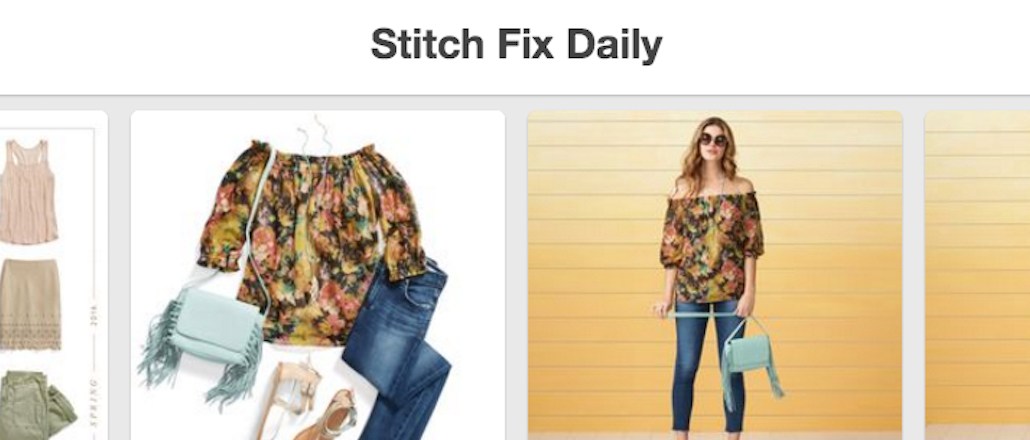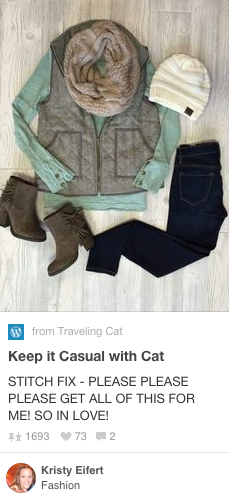
Stitch Fix, the online personal shopping service, has found a social media ally in Pinterest.
Launched in 2011 by CEO Katrina Lake, Stitch Fix combines algorithms, user-submitted data and the touch of a trained personal stylist to send customers a selection of new apparel and accessories. The recipient then pays only for what they want to keep, returning the rest. Stitch Fix reports that it has sent out “millions” of packages (called “fixes”) to customers, and recently added shoes to its service and began testing a menswear service in beta.
Julie Bornstein, the company’s COO and former CMO of Sephora, said that Stitch Fix has struck a chord with consumers because translating style inspiration is easier to do digitally, with the assistance of visuals, than it is in person with a stylist, through your own words.
“Style and fashion is so nuanced, and words can mean different things to different people,” said Bornstein. “Going digital replaces that moment when you walk into a store and try to describe to someone what your closet looks like, and can’t form it into coherent sentences.”
That’s how Pinterest, made for organizing visual inspiration, comes into play. When new users sign up for Stitch Fix, they fill out a lengthy questionnaire that informs stylists about their body type, favorite and least favorite colors and patterns, go-to style, workplace dress code, and willingness to take fashion risks. They look through collections of photos themed by style — boho, classic, preppy, glam — and answer how they feel about the aesthetic. As a last step, they’re prompted to link to an existing Pinterest board that captures their personal or aspirational style, or invited to do so later.
“We have a really high rate of Pinterest board creations,” said Bornstein. “It’s the best way to share inspiration — people capture ideas on Pinterest already, and they can do that with us in mind.”
On Pinterest, a search of “Stitch Fix” boards leads to pages of results, with top boards containing more than 700 pins, which are oftentimes paired with captions like “Stitch Fix! Please please please get this for me! So in love!” Stitch Fix’s own Pinterest account has 511,000 followers.

Bornstein said that users can share any social profile with Stitch Fix, like Instagram or Linkedin, but Pinterest is the company’s primary platform. She added that the relationship with Pinterest, which is unpaid, has become mutually beneficial for both platforms, in that Stitch Fix encourages users to create boards, Pinterest gets that engagement, and Stitch Fix stylists get the access to insight.
By pulling in Pinterest’s ability to compartmentalize something open-ended, like style, Stitch Fix is making customers’ lives easier, Bornstein believes.
“Consumers are facing a complete explosion of options,” she said. “It’s overwhelming, buying online is time consuming, and inspiration comes from so many different places. All of that, to some degree, we solve for.”
Stitch Fix, unlike other retailers, resonates on Pinterest because it’s not trying to get customers to buy based on what they’ve pinned. Instead, it’s delivering real-life iterations of what users are attracted to on the platform, according to Crystal Spence, senior consultant at Vivaldi Partners Group.
“Because of active consumer engagement on Pinterest, Stitch Fix is essentially selling style,” she said. “Customers feel confident that their style ideas and aspirations will come through when the box is delivered, completing their happy experience.”
But now, as Stitch Fix plans to expand full-time into menswear this fall, it’s not relying on Pinterest in the same way to drive stylists’ decisions. Men simply don’t use Pinterest at the same rate: 44 percent of online women use Pinterest, compared to 16 percent of online men, according to Aug. 2015 Pew Research. As the company shifts gears for menswear, a Pinterest-reliant social approach won’t work.
“They’re just not on Pinterest,” said Bornstein. “We’re going to have to try something new for men — we’ll be serving a broad range, so we can’t assume they’ll actually be interested in fashion.”
More in Marketing

Pandora is betting on AI agents to scale service and emotional selling during the peak holiday season
Pandora is using AI agents to scale customer service and replicate emotional in-store selling online, just as peak season puts pressure on margins and teams.

Rembrand’s CEO wants to grow virtual ad placements in streaming, and he’s looking elsewhere for models
Omar Tawakol wants to improve advertising within the streaming world, and is working with advertisers and publishers to improve that experience.

Marketers are keen to use generative AI in ad campaigns, but hidden costs lurk
Marketers across the industry want to use AI to cut down on time spent in creative production. It’s not so simple in practice.








